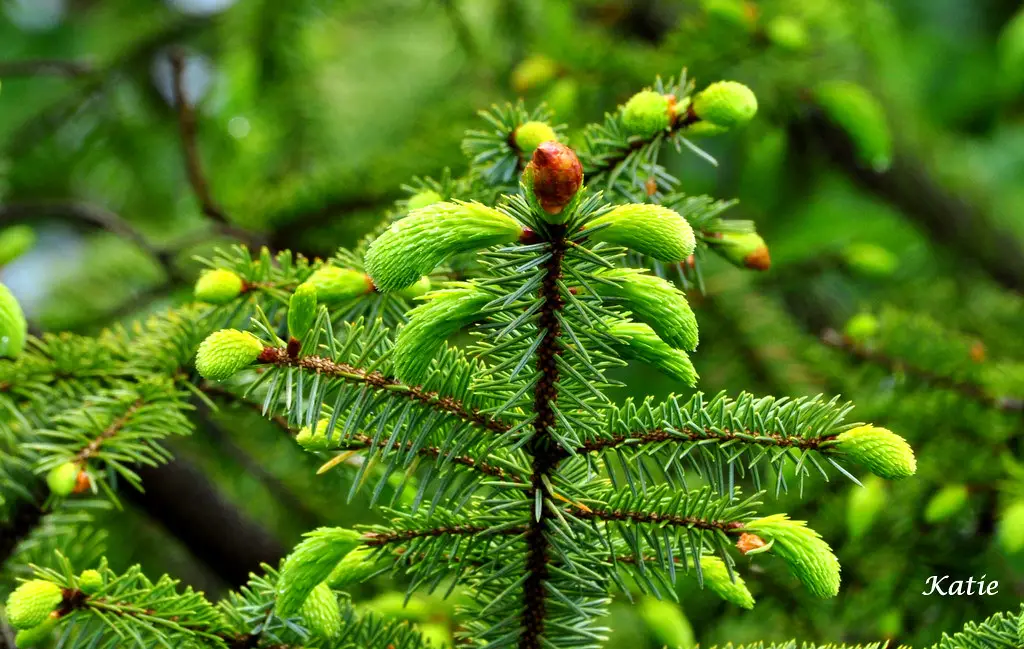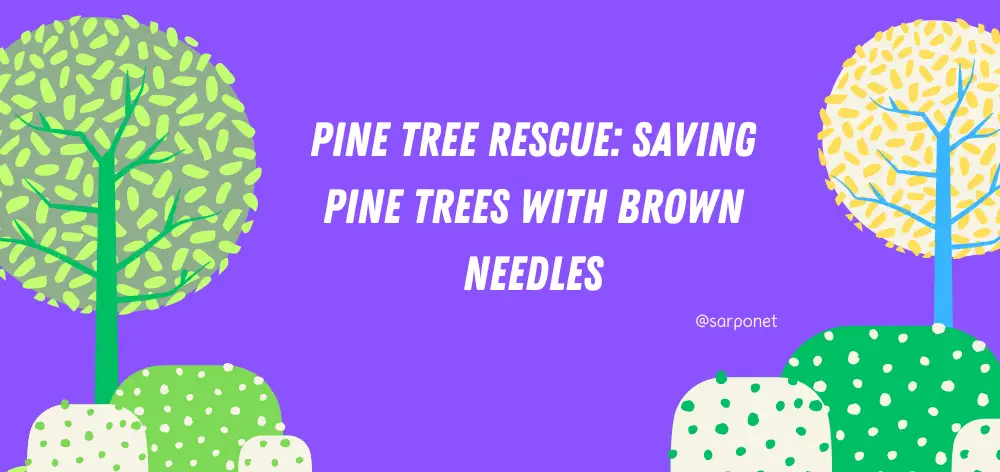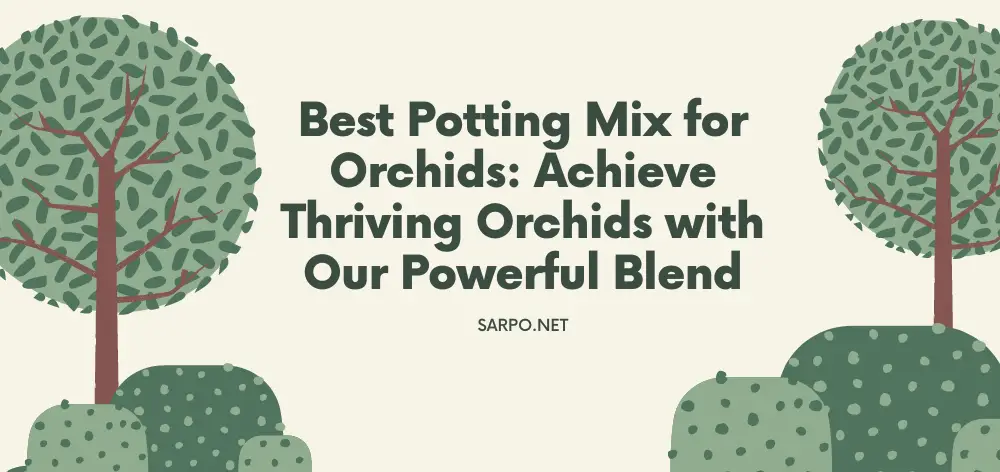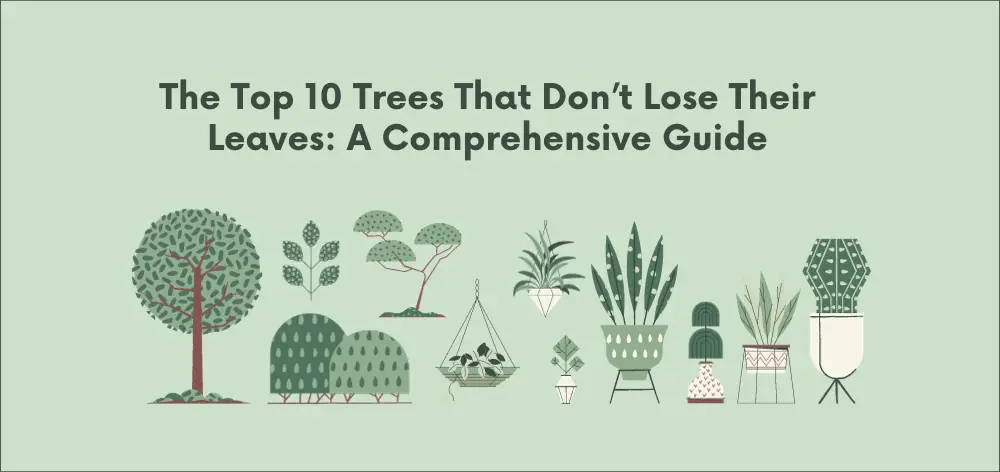
Top 10 Trees That Don’t Shed Leaves: Evergreen Beauties
Evergreen trees retain their leaves throughout the year. They add consistent greenery to landscapes and provide year-round beauty.
Evergreen trees are a popular choice for gardens and landscapes due to their perennial foliage. These trees maintain their leaves regardless of the season, offering a constant source of greenery. They are ideal for those who seek low-maintenance yet visually appealing flora.
Common examples include the majestic Magnolia, the versatile Holly, and the sturdy Pine. Their ability to stay lush throughout the year makes them invaluable for creating privacy screens, windbreaks, and decorative accents. By planting evergreen trees, one can enjoy a vibrant landscape even in the bleakest of winters. This guide explores the top ten trees that do not shed leaves, ensuring year-round beauty and utility.
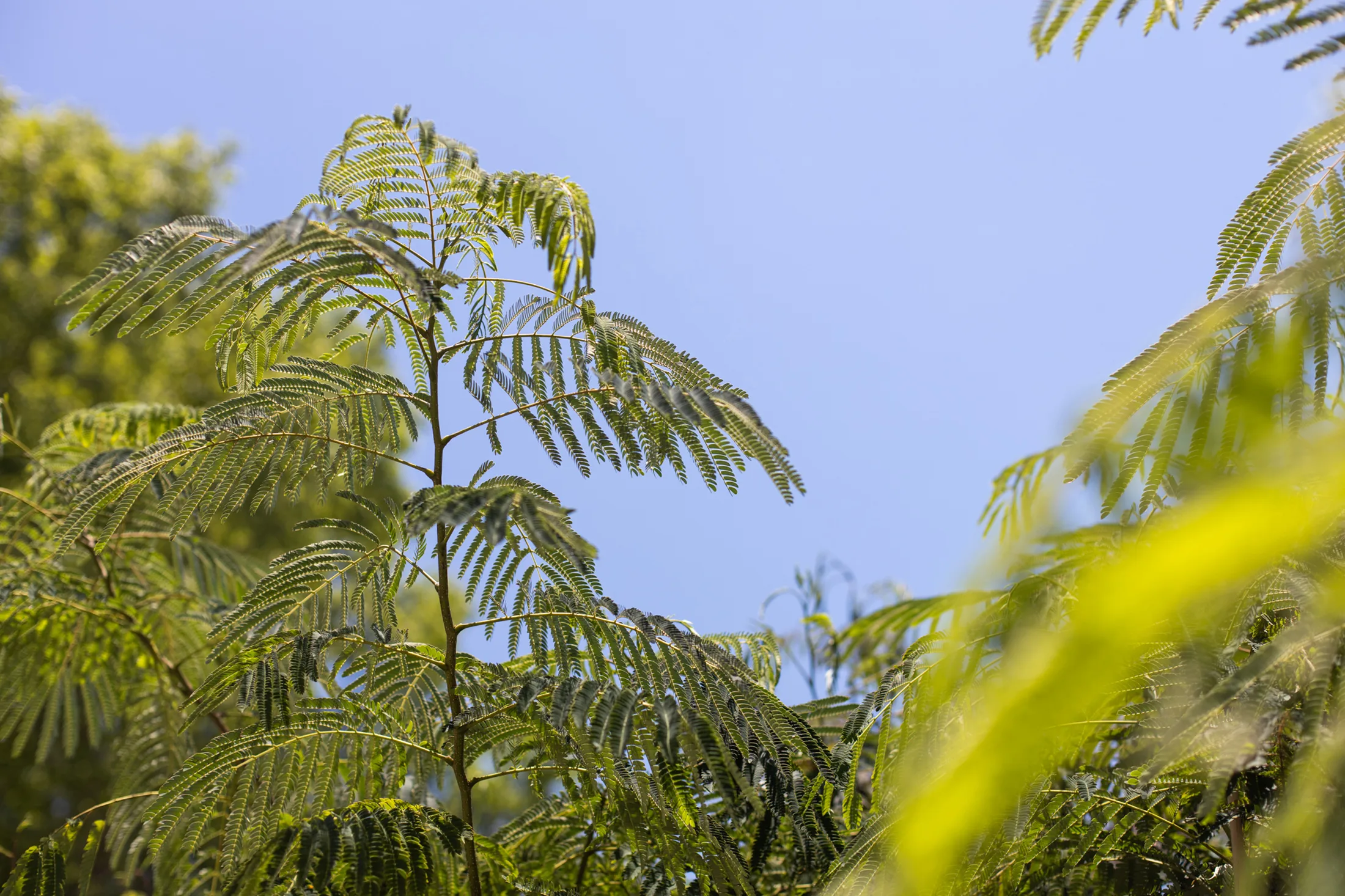
Credit: www.thetreecenter.com
So, What Are Evergreens?
Evergreens are trees that keep their leaves all year round. They offer a splash of green, even in winter. This guide helps you choose the top 10 trees that don’t shed leaves. Learn about the benefits of evergreens and why they are a great addition to your garden.
Importance Of Leaf Retention
Leaf retention is crucial for several reasons. Trees that keep their leaves provide continuous greenery and shade. They also offer windbreaks and privacy screens. Here are some key points:
- Continuous Shade: Evergreens offer shade throughout the year.
- Windbreaks: They protect against strong winds, reducing heating costs.
- Privacy Screens: Evergreens act as natural fences, offering privacy.
Leaf retention also benefits the environment. Evergreen trees absorb carbon dioxide all year long, helping fight climate change. They also provide habitats for wildlife, offering food and shelter.
Benefits Of Choosing Evergreens
Choosing evergreens for your garden offers many benefits. First, they are low-maintenance. You don’t have to rake leaves in fall, saving time and effort. Evergreens also add beauty to your garden with their lush green foliage. Here are some more benefits:
- Year-Round Beauty: Evergreens keep your garden green all year.
- Low Maintenance: No need to rake leaves.
- Improved Air Quality: They absorb pollutants and release oxygen.
Evergreens can also increase property value. A well-maintained garden with evergreens looks appealing. This can make your property more attractive to buyers. Additionally, evergreens provide noise reduction. Their dense foliage can block out noise, creating a peaceful environment.
1. Pine Trees
Pine trees are a popular choice for those seeking evergreen trees that retain their leaves year-round. These trees are not only visually appealing but also provide environmental benefits, such as producing oxygen and offering habitats for wildlife. In this section, we will explore the various types of pine trees and their ideal growing conditions.

Varieties Of Pine
Pine trees come in many varieties, each with unique characteristics. Here are some of the most common types:
- Eastern White Pine: Known for its tall and straight growth, this variety can reach up to 80 feet in height.
- Scots Pine: Recognizable by its orange-red bark, this tree is native to Europe and can grow up to 60 feet tall.
- Ponderosa Pine: Found in North America, this type can grow up to 100 feet tall and has a distinctive vanilla scent.
- Lodgepole Pine: This variety is smaller, usually growing up to 70 feet, and is often found in mountainous regions.
- Austrian Pine: Known for its dark green needles, this pine can grow up to 60 feet and is resistant to pollution.
Each of these varieties has different growth habits and visual characteristics. Some are tall and slender, while others are more broad and bushy.
Ideal Growing Conditions
Pine trees thrive in specific growing conditions. Understanding these conditions helps ensure their healthy growth:
- Soil: Pine trees prefer well-drained soil. Sandy or loamy soil types are ideal for their growth.
- Sunlight: These trees need full sunlight. Plant them in areas where they receive at least 6 hours of direct sunlight daily.
- Water: Pine trees require moderate watering. Ensure the soil is moist but not waterlogged.
- Temperature: Most pine trees grow well in temperate climates. They can withstand cold winters but may struggle in extreme heat.
Here’s a quick reference table for their ideal growing conditions:
| Condition | Requirement |
|---|---|
| Soil | Well-drained, sandy or loamy |
| Sunlight | Full sunlight (6+ hours) |
| Water | Moderate, moist but not waterlogged |
| Temperature | Temperate climates, tolerates cold |
Ensuring these conditions are met will help your pine trees grow strong and healthy. These trees add beauty and value to any landscape.
2. Spruce Trees
When it comes to evergreen trees, Spruce trees are some of the most popular choices. These trees don’t shed leaves, making them a favorite for year-round greenery. With their unique needle-like leaves and conical shape, spruce trees add beauty to any landscape.

Types Of Spruce
Spruce trees come in various types, each with unique characteristics:
- Norway Spruce: Known for its fast growth and dense foliage. It can reach up to 100 feet tall.
- Blue Spruce: Famous for its striking blue-green needles. It grows up to 75 feet.
- White Spruce: Offers a more subtle green color. It typically grows to about 60-70 feet.
- Black Spruce: Found in colder climates. It reaches heights of 50-65 feet.
Here’s a table summarizing the types of spruce trees:
| Type | Height | Needle Color |
|---|---|---|
| Norway Spruce | Up to 100 feet | Dark Green |
| Blue Spruce | Up to 75 feet | Blue-Green |
| White Spruce | 60-70 feet | Light Green |
| Black Spruce | 50-65 feet | Dark Green |
Landscaping Uses
Spruce trees are versatile in landscaping. They offer many uses:
- Privacy Screens: Their dense foliage makes them perfect for creating privacy hedges.
- Windbreaks: Planting them in rows can protect your property from strong winds.
- Ornamental Trees: The unique colors and shapes of spruce trees make them great focal points.
- Christmas Trees: Many people use spruce trees during the holiday season.
Here’s how spruce trees can enhance your landscape:
- Year-Round Greenery: These trees stay green all year, adding constant beauty to your yard.
- Low Maintenance: Spruce trees require minimal care once established.
- Wildlife Habitat: Birds and small animals love spruce trees for shelter.
With their various types and uses, spruce trees are a fantastic choice for any garden or yard.
3. Fir Trees
When searching for trees that don’t shed leaves, fir trees stand out as a fantastic option. These evergreen beauties are known for their lush, year-round foliage and striking appearance. Fir trees are commonly used as Christmas trees, but they offer much more than holiday charm. This guide covers everything you need to know about fir trees, from their unique characteristics to the best places to plant them.

Characteristics Of Fir
Fir trees are part of the Abies genus, which includes about 50 different species. These trees are evergreen conifers, meaning they keep their needles throughout the year. Fir needles are flat and soft to the touch, unlike the prickly needles of some other conifers.
Key characteristics of fir trees include:
- Needles: Flat, soft, and often have a distinct fragrance.
- Bark: Smooth and gray when young, becoming rough and furrowed with age.
- Cones: Upright and cylindrical, often disintegrating to release seeds.
- Height: Can range from 30 to 250 feet, depending on the species.
Fir trees are also known for their symmetrical shape and strong, straight trunks. These features make them popular in landscaping and forestry. The wood of fir trees is soft yet sturdy, making it useful for construction and paper products.
Best Locations For Fir Trees
Fir trees thrive in cool and moist climates. They are commonly found in mountainous regions and northern latitudes. Fir trees prefer well-drained soil and areas with plenty of sunlight.
Ideal locations for planting fir trees include:
- Mountain slopes: Elevations between 3,000 to 7,000 feet are optimal.
- Forest edges: Fir trees grow well in mixed forests with other conifers and hardwoods.
- Urban parks and gardens: Fir trees add aesthetic value and provide year-round greenery.
To ensure healthy growth, it’s important to consider the specific species of fir you are planting. For example, the Noble Fir and Douglas Fir are popular in the Pacific Northwest, while the Balsam Fir is commonly found in the Eastern United States.
Fir trees can also be planted in windbreaks and shelterbelts to protect against wind erosion and provide habitat for wildlife. With proper care and the right location, fir trees can become a stunning, long-lasting addition to any landscape.
4. Cypress Trees
Cypress trees are a top choice for those seeking evergreen beauty in their gardens. These trees are known for their lush, green foliage that remains vibrant throughout the year. Cypress trees not only provide aesthetic value but also serve as excellent privacy screens. Let’s explore the unique features and maintenance tips for Cypress trees.

Unique Features of Cypress
Cypress trees are well-loved for their distinctive features that set them apart from other evergreens. Here are some key characteristics:
- Evergreen Foliage: Cypress trees maintain their green leaves all year, providing a consistent, lush appearance.
- Conical Shape: Many Cypress species grow in a naturally conical shape, which adds vertical interest to any landscape.
- Diverse Varieties: There are several types of Cypress trees, including the Italian Cypress, Leyland Cypress, and Bald Cypress, each with unique growth habits and appearances.
- Resilience: Cypress trees are known for their resilience against pests and diseases, making them a low-maintenance option for many gardeners.
Here’s a table highlighting some popular Cypress tree varieties:
| Variety | Height | Growth Rate |
|---|---|---|
| Italian Cypress | 40-60 feet | Fast |
| Leyland Cypress | 60-70 feet | Fast |
| Bald Cypress | 50-70 feet | Moderate |
Maintenance Tips
Maintaining Cypress trees is straightforward with a few essential tips:
- Watering: Keep the soil moist, especially during the first two years after planting. Mature trees need less frequent watering.
- Pruning: Prune your Cypress trees in early spring to maintain their shape and remove any dead or damaged branches.
- Fertilization: Apply a balanced, slow-release fertilizer in early spring to support healthy growth.
- Mulching: Use mulch around the base of the tree to retain moisture and prevent weed growth.
Follow these steps to ensure your Cypress trees thrive:
- Check the soil moisture weekly and water deeply as needed.
- Inspect the tree for pests or diseases regularly and address any issues promptly.
- Remove any grass or weeds within a three-foot radius of the tree base to reduce competition for nutrients.
- Protect young trees from extreme weather with burlap wraps or windbreaks.
By following these maintenance tips, your Cypress trees will remain healthy and beautiful year-round.
5. Holly Trees
When choosing trees that don’t shed leaves, holly trees often stand out. These evergreen beauties are perfect for maintaining a lush, green landscape year-round. Holly trees bring vibrant color and structure to gardens and yards.

Holly Varieties
Holly trees come in many varieties, each with unique traits. Some popular types include:
- American Holly: Known for its classic appearance, it has dark green leaves and bright red berries.
- Japanese Holly: Features small, boxwood-like leaves and black berries.
- Chinese Holly: Recognizable by its glossy, spiny leaves and red fruits.
- English Holly: Famous for its spiky leaves and red berries, often used in Christmas decorations.
Here’s a quick comparison of some key holly varieties:
| Holly Variety | Leaf Type | Berry Color | Size (Height x Width) |
|---|---|---|---|
| American Holly | Dark Green, Spiny | Red | 30-50 ft x 18-40 ft |
| Japanese Holly | Small, Boxwood-like | Black | 6-10 ft x 6-10 ft |
| Chinese Holly | Glossy, Spiny | Red | 15-25 ft x 15-25 ft |
| English Holly | Spiky | Red | 15-50 ft x 15-25 ft |
Seasonal Appeal
Holly trees offer year-round appeal, making them a favorite among gardeners. Their evergreen leaves provide a constant splash of green, even in winter.
In spring and summer, holly trees boast lush foliage. During these seasons, their dense leaves create an ideal backdrop for other flowering plants.
As autumn approaches, some holly varieties produce vibrant berries. These berries remain through winter, adding pops of color against the green leaves. The red berries of American and English holly are particularly striking during the holiday season.
Here are a few highlights:
- Spring: New, bright green leaves appear.
- Summer: Full foliage creates dense greenery.
- Autumn: Berries start to develop, adding color.
- Winter: Evergreen leaves and berries provide visual interest.
This seasonal appeal makes holly trees a versatile choice for any landscape. They offer beauty and structure throughout the year.
6. Magnolia Trees
In this comprehensive guide, we explore the top 10 trees that don’t shed leaves. One standout is the magnificent Magnolia tree. Known for its large, fragrant blossoms and glossy green leaves, the Magnolia tree adds beauty and elegance to any landscape. This evergreen tree is not only eye-catching but also easy to maintain, making it a favorite among gardeners.

Types Of Magnolia
There are several types of Magnolia trees, each with unique characteristics. Here are some popular varieties:
- Southern Magnolia (Magnolia grandiflora): This iconic tree has large, white flowers and can grow up to 80 feet tall.
- Star Magnolia (Magnolia stellata): Known for its star-shaped flowers, this variety grows up to 20 feet and is perfect for smaller gardens.
- Saucer Magnolia (Magnolia x soulangeana): This hybrid tree has pink-purple flowers and grows between 20-30 feet tall.
- Sweetbay Magnolia (Magnolia virginiana): This tree has creamy white flowers and can grow between 10-35 feet tall.
To help you choose the right Magnolia for your garden, here’s a comparison table:
| Type | Height | Flower Color | Special Features |
|---|---|---|---|
| Southern Magnolia | 60-80 feet | White | Large, fragrant flowers |
| Star Magnolia | 15-20 feet | White | Star-shaped flowers |
| Saucer Magnolia | 20-30 feet | Pink-purple | Hybrid variety |
| Sweetbay Magnolia | 10-35 feet | Creamy white | Fragrant flowers |
Caring For Magnolias
Magnolia trees are relatively easy to care for. Here are some tips to keep them healthy and thriving:
- Planting Location: Choose a spot with full sun to partial shade. Ensure the soil is well-draining and slightly acidic.
- Watering: Water the tree regularly, especially during dry periods. Young Magnolias need more water to establish roots.
- Mulching: Apply a layer of mulch around the base of the tree to retain moisture and regulate soil temperature.
- Pruning: Prune the tree in late winter or early spring to remove dead or damaged branches. This encourages new growth and maintains the tree’s shape.
- Fertilizing: Use a slow-release fertilizer in the spring to provide essential nutrients. Avoid over-fertilizing, which can harm the tree.
By following these care tips, your Magnolia tree will remain healthy and beautiful year-round. With their stunning flowers and evergreen leaves, Magnolias are a perfect addition to any garden.
7. Juniper Trees
Welcome to “The Top 10 Trees That Don’t Shed Leaves Comprehensive Guide.” One of the most remarkable evergreens on this list is the Juniper tree. Known for its hardy nature and beautiful foliage, Juniper trees are a favorite for landscapes and gardens. They come in various shapes and sizes, adding a unique touch to any environment. Let’s dive deeper into the fascinating world of Juniper trees.

Uses Of Junipers
Juniper trees serve multiple purposes, making them a versatile choice for various applications:
- Landscaping: Junipers are excellent for landscaping due to their evergreen nature. They provide year-round color and texture.
- Windbreaks: Their dense foliage makes them ideal for windbreaks, protecting other plants and structures.
- Ground Cover: Certain varieties, like the creeping juniper, spread across the ground, preventing soil erosion.
- Privacy Screens: Tall varieties of Junipers can act as natural privacy screens, blocking unwanted views.
Junipers are not just functional but also aesthetically pleasing. Their blue-green needles and unique shapes add visual interest to any setting. Some species even produce berries, which are used in culinary and medicinal applications. For instance, juniper berries are a key ingredient in making gin.
Here’s a quick look at the common uses of Junipers:
| Use | Description |
|---|---|
| Landscaping | Provides year-round color and texture |
| Windbreaks | Protects other plants and structures |
| Ground Cover | Prevents soil erosion |
| Privacy Screens | Blocks unwanted views |
Growth Preferences
Understanding the growth preferences of Juniper trees is crucial for their successful cultivation:
- Soil: Junipers thrive in well-drained soil. They tolerate poor soil conditions but prefer sandy or rocky soils.
- Sunlight: These trees need full sun to partial shade. At least 6 hours of direct sunlight daily is ideal.
- Water: Junipers are drought-tolerant once established. They require minimal watering, making them low-maintenance.
- Climate: They are hardy in USDA zones 3-9, withstanding cold and hot temperatures.
Junipers grow well in a variety of conditions, but they perform best in dry, sunny locations. Overwatering can lead to root rot, so it’s important to allow the soil to dry out between waterings.
Here’s a summary of their growth preferences:
| Condition | Preference |
|---|---|
| Soil | Well-drained, sandy or rocky |
| Sunlight | Full sun to partial shade |
| Water | Minimal, drought-tolerant |
| Climate | USDA zones 3-9 |
By following these guidelines, you can ensure that your Juniper trees grow healthy and strong. They are resilient and adaptable, making them a great addition to any garden or landscape.
8. Boxwood Shrubs
Are you searching for trees that don’t shed leaves? Boxwood shrubs could be a great option. These evergreen shrubs maintain their lush, green foliage all year round. Boxwood shrubs are versatile, hardy, and perfect for various landscaping needs. Explore the different boxwood varieties and learn how to prune and shape them effectively.

Boxwood Varieties
Boxwood shrubs come in many varieties, each with unique characteristics. Here are some popular types:
- American Boxwood (Buxus sempervirens): Known for its dense foliage and ability to grow tall. Ideal for hedges.
- Korean Boxwood (Buxus sinica var. insularis): A hardy variety that can withstand cold temperatures. Perfect for colder climates.
- English Boxwood (Buxus sempervirens ‘Suffruticosa’): Compact and slow-growing, making it great for borders and small hedges.
- Japanese Boxwood (Buxus microphylla): Known for its small leaves and resistance to boxwood blight. Often used in topiary.
Each variety offers distinct advantages:
| Variety | Height | Climate Suitability |
|---|---|---|
| American Boxwood | Up to 20 feet | Moderate to warm climates |
| Korean Boxwood | 2-3 feet | Cold climates |
| English Boxwood | 2-3 feet | Moderate climates |
| Japanese Boxwood | 4-6 feet | Warm climates |
Choosing the right boxwood variety depends on your climate and landscaping needs. Each type offers unique features, so select the one that best fits your garden.
Pruning And Shaping
Pruning and shaping boxwood shrubs is essential to maintain their appearance and health. Follow these tips for best results:
- Use sharp, clean tools: Ensure your pruning shears are sharp to make clean cuts. Clean tools reduce the risk of disease.
- Prune in late spring: The best time to prune boxwood shrubs is late spring. The new growth will have time to mature before winter.
- Shape gradually: Trim small amounts regularly. Avoid cutting too much at once, which can stress the plant.
- Remove dead or damaged branches: Always cut away any dead or damaged branches. This promotes healthy growth.
- Thin out dense areas: If the shrub becomes too dense, thin out the inner branches. This improves air circulation and reduces disease risk.
Pruning and shaping techniques vary based on the desired shape:
| Shape | Method |
|---|---|
| Formal Hedge | Trim evenly along the top and sides. Maintain a clean, straight line. |
| Topiary | Shape into desired forms such as spheres or spirals. Regular trimming is essential. |
| Informal Shrub | Prune lightly to maintain natural shape. Focus on removing dead or crossing branches. |
Proper pruning and shaping ensure your boxwood shrubs remain healthy and attractive. Follow these guidelines to keep your garden looking its best all year round.
Choosing The Right Tree
Introduction paragraph about The Top 10 Trees That Don’T Shed Leaves Comprehensive Guide and Conclusion: Choosing the Right Tree. Selecting the perfect tree for your garden or landscape involves more than just aesthetics. Understanding the unique properties of non-deciduous trees, often referred to as trees that don’t shed leaves, is crucial. This guide aims to help you make an informed decision by exploring the factors to consider and the long-term benefits of these evergreen wonders.
Factors To Consider
Choosing the right tree involves multiple factors. Each factor contributes to how well the tree will thrive in its environment and meet your needs.
- Climate Compatibility: Ensure the tree suits your local climate. Some trees thrive in tropical climates, while others are suited for temperate zones.
- Soil Type: Different trees prefer different soil types. Check if your chosen tree requires sandy, loamy, or clay soil.
- Water Requirements: Some trees need frequent watering, while others are drought-tolerant.
- Growth Rate: Consider how quickly the tree grows. Fast-growing trees provide quick shade but might have weaker wood.
- Size at Maturity: Know the full-grown size of the tree to ensure it fits well in your space without overcrowding.
Here’s a quick comparison of some popular non-deciduous trees:
| Tree Type | Climate Suitability | Soil Preference | Water Needs |
|---|---|---|---|
| Oak Tree that Doesn’t Lose Leaves | Temperate | Well-drained | Moderate |
| Pine Tree | Cold | Sandy | Low |
| Magnolia | Subtropical | Rich, acidic | High |
Long-term Benefits
Non-deciduous trees offer numerous long-term benefits, making them an excellent choice for any landscape.
- Year-Round Greenery: Trees that don’t shed leaves provide constant greenery, enhancing your garden’s beauty throughout the year.
- Low Maintenance: These trees require less cleanup since they don’t drop leaves seasonally.
- Energy Savings: Evergreens act as windbreaks in winter and provide shade in summer, reducing energy costs.
- Wildlife Habitat: Non-deciduous trees offer shelter and food for various wildlife, promoting biodiversity.
Choosing trees that don’t lose their leaves also contributes to environmental stability. These trees help in carbon sequestration, improving air quality. They also prevent soil erosion with their year-round foliage.
Investing in non-deciduous trees ensures you enjoy the myriad benefits they offer. From aesthetic appeal to practical advantages, these trees are a valuable addition to any garden or landscape.
Frequently Asked Questions
What Trees Do Not Shed Leaves?
Evergreen trees like pine, cedar, and spruce do not shed leaves. They keep their foliage year-round.
Why Do Evergreen Trees Keep Their Leaves?
Evergreen trees retain leaves to conserve water and energy. This helps them survive in harsh climates.
Which Evergreen Trees Are Best For Privacy?
Arborvitae, Leyland cypress, and Eastern red cedar are ideal for privacy. They grow dense and tall.
Are There Flowering Evergreen Trees?
Yes, flowering evergreens like magnolia and camellia offer blooms and year-round foliage. They enhance garden beauty.
Conclusion
Choosing trees that don’t shed leaves ensures year-round greenery. This guide highlights the best options available. Carefully select the right tree for your space. Enjoy a low-maintenance, evergreen landscape. Your garden will thrive with these beautiful, enduring trees. Start planning your lush, leaf-retaining oasis today!
Related Articles
10 Best Small Evergreen Trees with Non Invasive Roots
 Dr Ahsanur Rahman, PHD
Dr Ahsanur Rahman, PHDPine Tree Rescue: Saving Pine Trees with Brown Needles
 Dr Ahsanur Rahman, PHD
Dr Ahsanur Rahman, PHD

